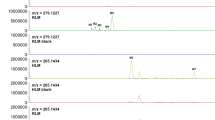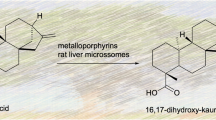Abstract
Carbonyl reduction is a significant step in the phase I biotransformation of a great variety of aromatic, alicyclic and aliphatic carbonyl compounds. 1-Furan-2-yl-3-pyridin-2-yl-propenone (FPP-3) has been shown to have anti-inflammatory activity as it inhibits the production of nitric oxide and tumor necrosis factor-β. In the present study, the metabolic fate and possible involvement of 11β-hydroxysteroid dehydrogenase (11β-HSD) and carbonyl reductase (CBR) in the metabolism of FPP-3 were investigated in rat liver subcellular fractions. When FPP-3 was incubated with rat liver subcellular fractions in the presence of β-NADPH, two major peaks were detected by reduction on the propenone: M1 (1-furan-2-yl-3-pyridin-2-yl-propan-1-one) and M2 (1-furan-2-yl-3-pyridin-2-yl-propan-1-ol). Inhibitors of CBR, such as quercitrin, ethacrynic acid and menadione, significantly increased the formation of M1, but effectively inhibited the formation of M2 in subcellular fractions. Meanwhile, 18β-glycyrrhetinic acid, a selective inhibitor of 11β-HSD, marginally inhibited the reduction of FPP-3 in microsomes. A good correlation was observed between the formation of M2 and CBR activity with either 4-pyridine carboxaldehyde (r=0.72) or D,L-glyceraldehyde (r=0.63) as substrates in the cytosol. These results indicated that FPP-3 might be metabolized by cytosolic CBR and uncharacterized microsomal reductase(s) in rat liver.
Similar content being viewed by others
References
Ahmed, N. K., Felsted, R. L., and Bachur, N. R., Heterogeneity of anthracycline antibiotic carbonyl reductase in mammalian livers. Biochem. Pharmacol., 27, 2713–2719 (1978).
Atalla, A. and Maser, E., Carbonyl reduction of the tobacco-specific nitrosamine 4-(methylnitrosamino)-1-(3-pyridyl)-1-butanone (NNK) in cytosol of mouse liver and lung. Toxicology, 139, 155–166 (1999).
Clement, B., Demesmaeker, M., and Linne, S., Microsomal catalyzed N-hydroxylation of guanabenz and reduction of the N-hydroxylated metabolites: characterization of the two reactions and genotoxic potential of guanoxabenz. Chem. Res. Toxicol., 9, 682–688 (1996).
Forrest, G. L. and Gonzalez, B., Carbonyl reductase. Chem. Biol. Interact. 129, 21–40 (2000).
Jahng, Y., Zhao, L. X., Moon, Y. S., Basnet, A., Kim, E. K., Chang, H. W., Ju, H. K., Jeong, T. C., and Lee, E. S., Simple aromatic compounds containing propenone moiety show considerable dual COX/5-LOX inhibitory activities. Bioorg. Med. Chem. Lett., 24, 2559–2562 (2004).
Lee, S. K., Jeon, T. W., Basnet, A., Lee, E. S., and Jeong, T. C., Identification of 1-furan-2-yl-3-pyridin-2-yl-propenone, an antiinflammatory agent, and its metabolites in rat liver subcellular fractions. Arch. Pharm. Res., 29, 984–989 (2006b).
Lee, S. K., Jeon, T. W., Basnet, A., Lee, E. S., and Jeong, T. C. Determination of 1-furan-2-yl-3-pyridin-2-yl-propenone, an anti-inflammatory propenone compounds, by high performance liquid chromatography with ultraviolet spectrometry. J. Chromatogr. B, 837, 108–111 (2006c).
Lee, E. S., Ju, H. K., Moon, T. C., Lee, E., Jahng, Y., Lee, S. H., Son, J. K., Baek, S. H., and Chang, H. W., Inhibition of nitric oxide and tumor necrosis factor-a production by propenone compound through blockade of nuclear factor-a activation in cultured murine macrophages. Biol. Pharm. Bull., 27, 617–620 (2004).
Lee, E. S., Park, B. C., Paek, S. H., Lee, Y. S., Basnet, A., Jin, D. Q., Choi, H. G., Yong, C. S., and Kim, J. A., Potent analgesic and anti-inflammatory activities of 1-furan-2-yl-3-pyridin-2-yl-propenone with gastric ulcer sparing effect. Biol. Pharm. Bull., 29, 361–364 (2006a).
Lowry, O. H., Rosenbrough, N. J., Farr, A. L., and Randall, R. J. Protein measurement with the folin phenol reagent. J. Biol. Chem., 193, 265–275 (1951).
Maser, E. and Bannenberg, G., 11 beta-hydroxysteroid dehydrogenase mediates reductive metabolism of xenobiotic carbonyl compounds. Biochem. Pharmacol., 47, 1805–1812 (1994).
Maser, E., Oppermann, U. C. T., Bannenberg, G., and Netter, K. J. Functional and immunological relationships between metyrapone reductase from mouse liver microsomes and 3 alpha-hydroxysteroid dehydrogenase from Pseudomonas testosteroni. FEBS Lett., 297, 196–200 (1992).
Maser, E., 11β-Hydroxysteroid dehydrogenase acts as carbonyl reductase in microsomal phase 1 drug metabolism. Exp. Toxic. Pathol., 48, 266–273 (1996).
Maser, E., Friebertshäuser, J., and Völker, B., Purification, characterization and NNK carbonyl reductase activities of 11β-hydroxysteroid dehydrogenase type 1 from human liver: enzyme cooperativity and significance in the detoxification of a tobacco-derived carcinogen. Chem-Biol. Interact., 143–144, 435–448 (2003).
Maser, E., Xenobiotic carbonyl reduction and physiological steroid oxidoreduction. Biochem. Pharmacol., 49, 421–440 (1995).
Ohara, H., Miyabe, Y., Detashiki, Y., Matsuura, K., and Hara, A., Reduction of drug ketones by dihydrodiol dehydrogenases, carbonyl reductase and aldehyde reductase of human liver. Biochem. Pharmacol., 50, 221–227 (1995).
Oppermann, U. C. T. and Maser, E., Molecular and structural aspects of xenobiotic carbonyl metabolizing enzymes. Role of reductases and dehydrogenase in xenobiotic phase I reactions. Toxicology, 144, 71–81 (2000).
Oppermann, U. C. T., Möbus, E., Nagal, G., and Maser, E., Heterogeneity of 11β-hydroxysteroid dehydrogenase type 1/microsomal carbonyl reductase (11β-HSD/CR) in guinea pig tissues. Purification of the liver form suggests modification in the cosubstrate binding site. Toxicology, 144, 63–69 (2000).
Szotáková, B., Baliharová, V., Lamka, J., NoŽinová, E., Wsól, V., Velík, J., Machala, M., Neéa, J., Souéek, P., Šusová, S., and Skálová, L., Comparison of in vitro activities of biotransformation enzymes in pig, cattle, goat and sheep. Res. Vet. Sci., 76, 43–51 (2004).
Author information
Authors and Affiliations
Corresponding author
Rights and permissions
About this article
Cite this article
Lee, S.K., Kim, J.H., Seo, Y.M. et al. In vitro characterization of the enzymes involved in the metabolism of 1-Furan-2-yl-3-pyridin-2-yl-propenone, an anti-inflammatory propenone compound. Arch. Pharm. Res. 31, 764–770 (2008). https://doi.org/10.1007/s12272-001-1224-3
Received:
Revised:
Accepted:
Published:
Issue Date:
DOI: https://doi.org/10.1007/s12272-001-1224-3




